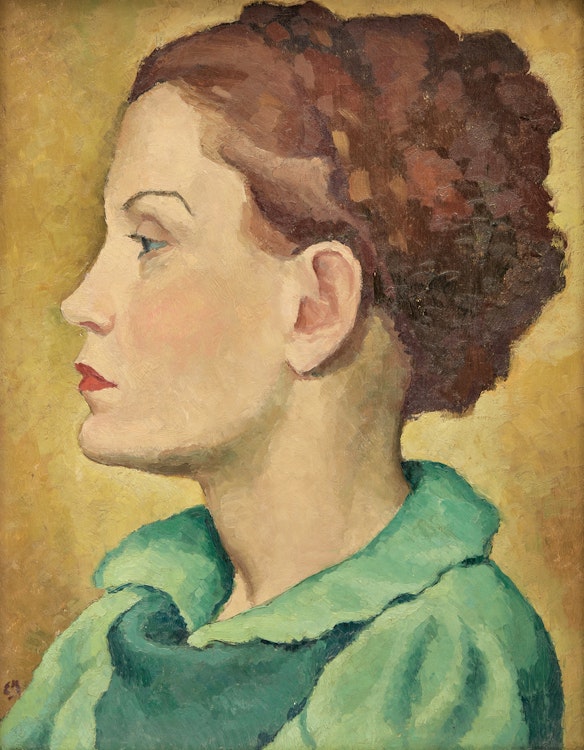Madeleine, 1937 by Edwin Headley Holgate

Edwin Holgate
Madeleine, 1937
oil on board
signed with initials lower left
16 x 12.5 in ( 40.6 x 31.8 cm )
Auction Estimate: $20,000.00 - $30,000.00
Price Realized $43,200.00
Sale date: May 30th 2024
Dominion Gallery, Montreal
Madeleine Rocheleau Boyer, circa 1955
Estate of Madeleine Rocheleau Boyer
Masters Gallery, Calgary
Private Collection
"Edwin Holgate", Montreal Museum of Fine Arts; travelling to the Glenbow Museum, Calgary; McMichael Canadian Art Collection, Kleinburg, Ontario; National Gallery of Canada, Ottawa; Beaverbrook Art Gallery, Fredericton, 26 May 2005-15 April 2007, no. 91
Dennis Reid, "Edwin Holgate", Ottawa, 1976, no. 44, reproduced page 67
Brian Foss, Rosalind Pepall and Laura Brandon, "Edwin Holgate", 2005, no. 91, reproduced page 152
Holgate’s portrait of Madeleine Rocheleau Boyer alludes to both traditional and modernist conventions of portraiture. The studied composition of the sitter in profile harkens back to portraits of the early Renaissance. Similar profile views were favoured in the coins of ancient Greek and Rome. Europe of the fifteenth century had seen a revival of the art of antiquity, which coincided with a greater interest in individual identity and a new emphasis on portraiture. While Holgate based "Madeleine" on these traditional conventions, the model’s hair and makeup root the painting in the 1930s. The subjects of Holgate’s portraits tended to be family and friends of the artist. An artist herself, Madeleine Rocheleau Boyer worked at the studio of Holgate and Ernest Neumann. Popular as an artist’s model, Rocheleau posed for some of Holgate’s most celebrated oils of nudes in landscapes, including "Early Autumn" of 1938. In later years, she would exhibit her own work regularly in Montreal. Here, her expression appears stoic and introspective. Acclaimed for his portraits and nudes, Holgate’s interest in the formal possibilities of portraiture are evidenced by his methodical, carefully structured works.
Share this item with your friends
Edwin Headley Holgate
(1892 - 1977) Group of Seven, Canadian Group of Painters, Beaver Hall Group, RCA
Edwin Holgate was born in Allandale, Ontario. Holgate began his art education at the Art Association of Montreal studying under William Brymner who was also A.Y. Jackson's teacher. In 1912 he went to Paris where he studied at the Académie de la Grande Chaumière under Claudio Castelucho and later under Lucien Simon and René Ménard. He was in Russia at the outbreak of the First World War. He returned to Canada where he enlisted and served with the 5th Canadian Division Artillery in France (1916-19). He married Mary Frances Rittenhouse in 1920 and returned to Paris where he continued his studies. There he attended the Colarossi under Adolph Milman, a Russian refugee.
He returned with his wife to Canada in 1922 and opened a studio. He taught wood engraving at the Ecole des Beaux Arts for six years. In Montreal he enjoyed the friendship of A.Y. Jackson, Clarence Gagnon, Mabel May, Lilas Newton, Randolph Hewton, and many of the younger artists who became known as the Beaver Hall Hill Group. Holgate was a good skier and he would take trips to various parts of Quebec to sketch during the winters, sometimes at Baie St. Paul where A.Y. Jackson, Clarence Gagnon, Mabel May and others would congregate.
In 1926 he accompanied A.Y. Jackson and Marius Barbeau to the Skeena River area in British Columbia. Barbeau had been investigating the condition of the Indian totem poles, many of which were restored by the C.N.R. engineer Mr. T.B. Campbell. Holgate and Jackson made a number of sketches of the poles and the Indian villages in the area. From his sketches, Holgate made several large canvases. One is in the collection of the National Gallery and entitled is “Totem Poles, Gitsegiuklas”.
Holgate became the eighth member of the Group of Seven in 1931 and remained a member of the Group until it disbanded in 1933. From it arose the Canadian Group of Painters of which he was a founding member. Paul Duval noted that Holgate and Varley were the only members of the Group who drew and painted nudes. Holgate was well known also for his portraits and did many striking character studies of inhabitants of Canadian bush country. The Art Gallery of Ontario and the National Gallery of Canada have his nude studies in their collections.
During the Second World War, Holgate served overseas as an official Canadian war artist with the R.C.A.F. and painted mainly portraits of flying officers. Holgate’s wood-engravings are exceptionally well done and interesting. He was a member of the Royal Canadian Academy (A.R.C.A. 1934 - R.C.A. 1935). His work has been exhibited in many group shows over the years. He is represented in many collections including the National Gallery of Canada, the Art Gallery of Ontario, the Art Gallery of Hamilton and the McMichael Collection.
Source: "A Dictionary of Canadian Artists, Volume II”, compiled by Colin S. MacDonald, Canadian Paperbacks Publishing Ltd, Ottawa, 1979

